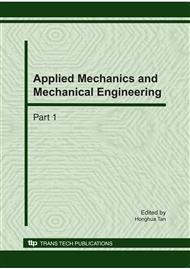[1]
Xie Y. M., Steven G. P., Evolutionary structural optimization. Springer-Verlag, Berlin, German, (1997).
Google Scholar
[2]
John. H. Holland, Adaptation in nature and artificial system: an introductory analysis with applications to biology, control, and artificial intelligence. Cambridge, MA: MIT Press, (1975).
Google Scholar
[3]
M. P. Bendsøe, Optimal shape design as a material distribution problem, Structural and Multidisciplinary Optimization, Vol. 1(1989), p.193.
DOI: 10.1007/bf01650949
Google Scholar
[4]
Eschenauer H. A., Olhoff N., Topology optimization of continuum structures: a review, Applied Mechanics Review, Vol. 54(2001), p.331.
DOI: 10.1115/1.1388075
Google Scholar
[5]
Bendsoe M. P., Kikuchi N., Generating optimal topologies in structural design using a homogenization method, Computer Methods in Applied Mechanics and Engineering, Vol. 71(1988), p.197.
DOI: 10.1016/0045-7825(88)90086-2
Google Scholar
[6]
Makoto Ohsaki, Simultaneous optimization of topology and geometry of a regular plane truss, Computers and Structures, Vol. 66(1998), p.69.
DOI: 10.1016/s0045-7949(97)00050-3
Google Scholar
[7]
Chyi-Yeu Lin, Shin-Hong Lin, Artificial neural network based hole image interpretation techniques for integrated topology and shape optimization, Computer Methods in Applied Mechanics and Engineering, Vol. 194(2005), p.3817.
DOI: 10.1016/j.cma.2004.09.005
Google Scholar
[8]
Mehrdad Salami, Tim Hendtlass, A fast evaluation strategy for evolutionary algorithms, Applied Soft Computing, Vol. 2(2003), p.156.
DOI: 10.1016/s1568-4946(02)00067-4
Google Scholar
[9]
Soon Yu Woon, Liyong Tong, Osvaldo M. Querin and Grant P. Steven, Effective optimization of continuum topologies through a multi-GA system, Computer Methods in Applied Mechanics and Engineering, Vol. 194(2005), p.3416.
DOI: 10.1016/j.cma.2004.12.025
Google Scholar
[10]
X.Y. Yang, Y.M. Xie and G.P. Steven, Evolutionary methods for topology optimization of continuous structures with design dependent loads, Computers and Structures, Vol. 83(2005), p.956.
DOI: 10.1016/j.compstruc.2004.10.011
Google Scholar
[11]
Y. M. Xie, G. P. Steven, A simple evolutionary procedure for structure optimization, Computers and Structures, Vol. 49(1993), p.885.
DOI: 10.1016/0045-7949(93)90035-c
Google Scholar
[12]
G. P. Steven, Q. Li, Y. M. Xie, Multi-criteria optimization that minimizes maximum stress and maximizes stiffness, Computers and Structures, Vol. 80(2002), p.2433.
DOI: 10.1016/s0045-7949(02)00235-3
Google Scholar
[13]
G. Marckmann P. Bettess and B. Peseux, Self designing structures: a new evolutionary rule for thickness distribution in 2D problems, Communications in Numerical Methods in Engineering, Vol. 18(2002), p.743.
DOI: 10.1002/cnm.534
Google Scholar
[14]
H. A. Eschenauer, H. A. Kobelev, A. schumacher, Bubble method for topology and shape optimization of structures, Structural and Multidisciplinary Optimization, Vol. 8(1994), p.142.
DOI: 10.1007/bf01742933
Google Scholar
[15]
Stanley Osher, and Ronald P., Fedkiwy, Level set methods: an overview and some recent results, Journal of Computational Physics, Vol. 169(2001), p.463.
DOI: 10.1006/jcph.2000.6636
Google Scholar
[16]
J. A. Sethian, Level set methods and fast marching methods evolving interfaces in computational geometry, fluid mechanics, computer vision, and materials science, Cambridge University Press, (1999).
DOI: 10.1016/s0997-7546(00)01096-7
Google Scholar
[17]
Stanley J. Osher, Ronald P., Fedkiw. Level set methods and dynamic implicit surfaces,Springer-Verlag, (2000).
Google Scholar
[18]
Stanley Osher, J. A. Sethian, Fronts propagating with curvature-dependent speed: algorithm based on hamilton-jacobi formulations, Journal of Computational Physics, Vol. 79(1988), p.12.
DOI: 10.1016/0021-9991(88)90002-2
Google Scholar
[19]
J. A. Sethian and Andreas Wiegmann, Structural boundary design via level set and immersed interface methods, Journal of Computational Physics, Vol. 163(2000), p.489.
DOI: 10.1006/jcph.2000.6581
Google Scholar
[20]
Stanley J. Osher, Fadil Santosay, Level set methods for optimization problems involving geometry and constraints, Journal of Computational Physics, Vol. 171(2001), p.272.
DOI: 10.1006/jcph.2001.6789
Google Scholar
[21]
Michael Yu Wang, Xiaoming Wang, Dongming Guo, A level set method for structural topology optimization, Computer Methods in Applied Mechanics and Engineering, Vol. 192(2003), p.227.
DOI: 10.1016/s0045-7825(02)00559-5
Google Scholar
[22]
G. Allaire, F. Jouve, A level-set method for vibration and multiple loads structural optimization, Computer Methods in Applied Mechanics and Engineering, Vol. 194(2005), p.3269.
DOI: 10.1016/j.cma.2004.12.018
Google Scholar
[23]
A. Rietz, Sufficiency of a finite exponent in SIMP (power law) methods, Structural and Multidisciplinary Optimization, Vol. 21(2001), pp.159-163.
DOI: 10.1007/s001580050180
Google Scholar
[24]
C. Y. Lin, L. S. Chao, Automated image interpretation for integrated topology and shape optimization, Structural and Multidisciplinary Optimization, Vol. 1(2000), p.125.
DOI: 10.1007/s001580050144
Google Scholar


